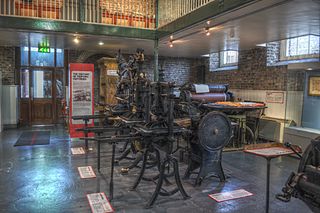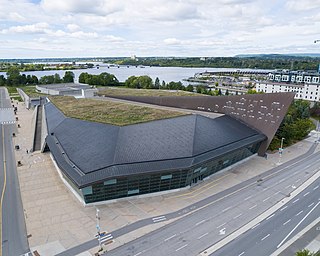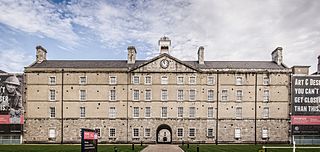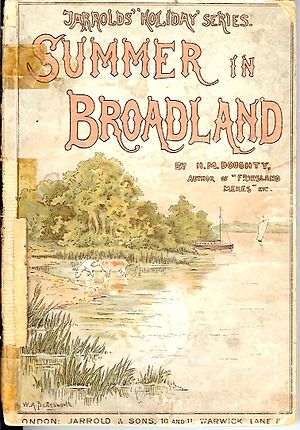
The National Print Museum in Beggar's Bush, Dublin, Ireland, collects, and exhibits a representative selection of printing equipment, and samples of print, and fosters associated skills of the printing craft in Ireland. It was opened in 1996.

The National Railway Museum is a museum in York forming part of the Science Museum Group. The museum tells the story of rail transport in Britain and its impact on society. It is the home of the national collection of historically significant railway vehicles such as Mallard, Stirling Single, Duchess of Hamilton and a Japanese bullet train. In addition, the National Railway Museum holds a diverse collection of other objects, from a household recipe book used in George Stephenson's house to film showing a "never-stop railway" developed for the British Empire Exhibition. It has won many awards, including the European Museum of the Year Award in 2001.

The Canadian War Museum is a national museum on the country's military history in Ottawa, Ontario, Canada. The museum serves as both an educational facility on Canadian military history and a place of remembrance. The 40,860 square metres (439,800 sq ft) museum building is situated south of the Ottawa River in LeBreton Flats. The museum houses a number of exhibitions and memorials, in addition to a cafeteria, theatre, curatorial and conservation spaces, as well as storage space. The building also houses the Military History Research Centre, the museum's library and archives.

A curator is a manager or overseer. When working with cultural organizations, a curator is typically a "collections curator" or an "exhibitions curator", and has multifaceted tasks dependent on the particular institution and its mission. The term "curator" may designate the head of any given division, not limited to museums. Curator roles include "community curators", "literary curators", "digital curators" and "biocurators".

The National Library of Ireland is the Republic of Ireland's national library located in Dublin, in a building designed by Thomas Newenham Deane. The mission of the National Library of Ireland is "To collect, preserve, promote and make accessible the documentary and intellectual record of the life of Ireland and to contribute to the provision of access to the larger universe of recorded knowledge."

The Wolfsonian–Florida International University or The Wolfsonian-FIU, located in the heart of the Art Deco District of Miami Beach, Florida, is a museum, library and research center that uses its collection to illustrate the persuasive power of art and design. For fifteen years, The Wolfsonian has been a division within Florida International University.

The History of Science Museum in Broad Street, Oxford, England, holds a leading collection of scientific instruments from Middle Ages to the 19th century. The museum building is also known as the Old Ashmolean Building to distinguish it from the newer Ashmolean Museum building completed in 1894. The museum was built in 1683, and it is the world's oldest surviving purpose-built museum.

The Rosenbach is a Philadelphia museum and library located within two 19th-century townhouses. The historic houses contain the collections and treasures of Philip Rosenbach and his younger brother Dr. A. S. W. Rosenbach. The brothers owned the Rosenbach Company, which became the preeminent dealer of rare books, manuscripts and decorative arts during the first half of the 20th century. Dr. Rosenbach in particular was seminal in the rare book world, helping to build libraries such as the Widener Library at Harvard, The Huntington Library and the Folger Shakespeare Library. In 2013, the Rosenbach became a subsidiary of the Free Library of Philadelphia Foundation, but maintains its own board and operates independently of the public library system.

A museum is distinguished by a collection of often unique objects that forms the core of its activities for exhibitions, education, research, etc. This differentiates it from an archive or library, where the contents may be more paper-based, replaceable and less exhibition oriented, or a private collection of art formed by an individual, family or institution that may grant no public access. A museum normally has a collecting policy for new acquisitions, so only objects in certain categories and of a certain quality are accepted into the collection. The process by which an object is formally included in the collection is called accessioning and each object is given a unique accession number.

Auckland Art Gallery Toi o Tāmaki is the principal public gallery in Auckland, New Zealand. It has the most extensive collection of national and international art in New Zealand and frequently hosts travelling international exhibitions.

The Arizona State Museum (ASM), founded in 1893, was originally a repository for the collection and protection of archaeological resources. Today, however, ASM stores artifacts, exhibits them and provides education and research opportunities. It was formed by authority of the Arizona Territorial Legislature. The museum is operated by the University of Arizona, and is located on the university campus in Tucson.

Blinken Open Society Archives is an archival repository and laboratory that aims to explore new ways of assessing, contextualizing, presenting, and making use of archival documents both in a professional and a consciously activist way. It was founded by George Soros in 1995, and opened in 1996 as a department of the Central European University. Originally called simply Open Society Archives (OSA), in 2015 it was renamed Vera and Donald Blinken Open Society Archives after receiving a major donation from the couple.

The Canada Science and Technology Museum is a national museum of science and technology in Ottawa, Ontario, Canada. The museum has a mandate to preserve and promote the country's scientific and technological heritage. The museum is housed in a 13,458 square metres (144,860 sq ft) building. The museum is operated by Ingenium, a Crown corporation that also operates two other national museums of Canada.

Auckland Libraries is the public library system for the Auckland Region of New Zealand. It was created when the seven separate councils in the Auckland region merged in 2010. It is currently the largest public-library network in the Southern Hemisphere with 55 branches from Wellsford to Waiuku. Currently from March 2021, the region has a total of 56 branches.

The National Museum of Ireland – Decorative Arts and History is a branch of the National Museum of Ireland (NMI) located at the former Collins Barracks in the Arbour Hill area of Dublin, Ireland.

Collections management involves the development, storage, and preservation of cultural property, as well as objects of contemporary culture in museums, libraries, archives and private collections. The primary goal of collections management is to meet the needs of the individual collector or collecting institution's mission statement, while also ensuring the long-term safety and sustainability of the cultural objects within the collector's care. Collections management, which consists primarily of the administrative responsibilities associated with collection development, is closely related to collections care, which is the physical preservation of cultural heritage. The professionals most influenced by collections management include collection managers, registrars, and archivists.

The Tucson Museum of Art and Historic Block (TMA) is an art museum and art education institution located in the Presidio District of downtown Tucson, Arizona. The museum comprises 74,000-square-feet of exhibition space over a four-acre city block that includes a contemporary main museum and 19th C. historic homes, including the Cordova House (1848), that have been adapted for reuse as the museum restaurant, pottery school, and galleries.

The exhibition of cultural property is a practice used by organizations where collected objects are put on display to the public. The objects are carefully chosen and placed together to offer educational value, and often to tell a story.
NIVAL (National Irish Visual Arts Library) is a public research resource which is dedicated to the documentation of twentieth- and twenty-first-century Irish visual art and design. It collects, stores and makes available for research documentation of Irish art and design in all media. NIVAL's collection policy encompasses Irish art and design from the entire island, Irish art and design abroad, and non-Irish artists and designers working in Ireland. NIVAL is sustained by material contributions from artists, arts organisations and arts workers. Information is also acquired from galleries, cultural institutions, critics, the art and design industries, and national and local authorities responsible for the visual arts. NIVAL is housed on the campus of the National College of Art and Design (NCAD) in Dublin.


















